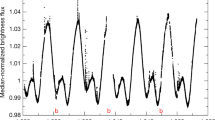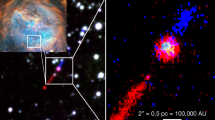Abstract
Pulsars are rotating, magnetized neutron stars that are born in supernova explosions following the collapse of the cores of massive stars. If some of the explosion ejecta fails to escape, it may fall back onto the neutron star1 or it may possess sufficient angular momentum to form a disk2. Such ‘fallback’ is both a general prediction of current supernova models3 and, if the material pushes the neutron star over its stability limit, a possible mode of black hole formation4. Fallback disks could dramatically affect the early evolution of pulsars2,5, yet there are few observational constraints on whether significant fallback occurs or even the actual existence of such disks. Here we report the discovery of mid-infrared emission from a cool disk around an isolated young X-ray pulsar. The disk does not power the pulsar's X-ray emission but is passively illuminated by these X-rays. The estimated mass of the disk is of the order of 10 Earth masses, and its lifetime (≥ 106 years) significantly exceeds the spin-down age of the pulsar, supporting a supernova fallback origin. The disk resembles protoplanetary disks seen around ordinary young stars6, suggesting the possibility of planet formation around young neutron stars.
This is a preview of subscription content, access via your institution
Access options
Subscribe to this journal
Receive 51 print issues and online access
$199.00 per year
only $3.90 per issue
Buy this article
- Purchase on Springer Link
- Instant access to full article PDF
Prices may be subject to local taxes which are calculated during checkout



Similar content being viewed by others
References
Colgate, S. A. Neutron-star formation, thermonuclear supernovae, and heavy-element reimplosion. Astrophys. J. 163, 221–230 (1971)
Michel, F. C. & Dessler, A. J. Pulsar disk systems. Astrophys. J. 251, 654–664 (1981)
Heger, A., Fryer, C. L., Woosley, S. E., Langer, N. & Hartmann, D. H. How massive single stars end their life. Astrophys. J. 591, 288–300 (2003)
Chevalier, R. A. Neutron star accretion in a supernova. Astrophys. J. 346, 847–859 (1989)
Menou, K., Perna, R. & Hernquist, L. Disk-assisted spin-down of young radio pulsars. Astrophys. J. 554, L63–L66 (2001)
Beckwith, S. V. W., Sargent, A. I., Chini, R. S. & Guesten, R. A survey for circumstellar disks around young stellar objects. Astron. J. 99, 924–945 (1990)
Woods, P. & Thompson, C. in Compact Stellar X-Ray Sources (eds Lewin, W. & van der Klis, M.) (Cambridge Univ. Press, in the press); preprint at http://arXiv.org/astro-ph/0406133 (2006)
Thompson, C. & Duncan, R. The soft gamma repeaters as very strongly magnetized neutron stars. II. Quiescent neutrino, X-ray, and Alfven wave emission. Astrophys. J. 473, 322–342 (1996)
van Paradijs, J., Taam, R. E. & van den Heuvel, E. P. J. On the nature of the ‘anomalous’ 6-s X-ray pulsars. Astron. Astrophys. 299, L41–L44 (1995)
Alpar, M. A. On young neutron stars as propellers and accretors with conventional magnetic fields. Astrophys. J. 554, 1245–1254 (2001)
Chatterjee, P., Hernquist, L. & Narayan, R. An accretion model for anomalous X-ray pulsars. Astrophys. J. 534, 373–379 (2000)
Hulleman, F., van Kerkwijk, M. H. & Kulkarni, S. R. The anomalous X-ray pulsar 4U 0142 + 61: variability in the infrared and a spectral break in the optical. Astron. Astrophys. 416, 1037–1045 (2004)
Durant, M. & van Kerkwijk, M. H. The red clump method for reddening and distance determination for the anomalous X-ray pulsars. Astrophys. J. (submitted)
Hulleman, F., van Kerkwijk, M. H. & Kulkarni, S. R. An optical counterpart to the anomalous X-ray pulsar 4U0142 + 61. Nature 408, 689–692 (2000)
Perna, R., Hernquist, L. & Narayan, R. Emission spectra of fallback disks around young neutron stars. Astrophys. J. 541, 344–350 (2000)
Israel, G., et al. in Young Neutron Stars and Their Environments (eds Camilo, F. & Gaensler, B. M.) 247–250 (IAU Symp. 218, Astron. Soc. Pacific, San Francisco, 2004)
Kern, B. & Martin, C. Optical pulsations from the anomalous X-ray pulsar 4U0142 + 61. Nature 417, 527–529 (2002)
Vrtilek, S. D. et al. Observations of Cygnus X-2 with IUE—ultraviolet results from a multiwavelength campaign. Astron. Astrophys. 235, 162–173 (1990)
Durant, M. & van Kerkwijk, M. H. The broadband spectrum and infrared variability of the magnetar AXP 1E 1048.1–5937. Astrophys. J. 627, 376–382 (2005)
Tam, C. R., Kaspi, V. M., van Kerkwijk, M. H. & Durant, M. Correlated infrared and X-ray flux changes following the 2002 outburst of the anomalous X-ray pulsar 1E 2259 + 586. Astrophys. J. 617, L53–L56 (2004)
de Jong, J. A., van Paradijs, J. & Augusteijn, T. Reprocessing of X-rays in low-mass X-ray binaries. Astron. Astrophys. 314, 484–490 (1996)
Wolszczan, A. & Frail, D. A. A planetary system around the millisecond pulsar PSR1257 + 12. Nature 355, 145–147 (1992)
Wolszczan, A. Confirmation of Earth-mass planets orbiting the millisecond pulsar PSR B1257 + 12. Science 264, 538–542 (1994)
Gavriil, F. P. & Kaspi, V. M. Long-term Rossi X-Ray Timing Explorer monitoring of anomalous X-ray pulsars. Astrophys. J. 567, 1067–1076 (2002)
Ekşi, K. Y., Hernquist, L. & Narayan, R. Where are all the fallback disks? Constraints on propeller systems. Astrophys. J. 623, L41–L44 (2005)
Phinney, E. S. & Hansen, B. M. S. in Planets Around Pulsars (eds Phillips, J. A., Thorsett, S. E. & Kulkarni, S. R.) 371–390 (ASP Conf. Vol. 36, Astron. Soc. Pacific, San Francisco, 1993)
Miller, M. C. & Hamilton, D. P. Implications of the PSR 1257 + 12 planetary system for isolated millisecond pulsars. Astrophys. J. 550, 863–870 (2001)
Hurley, K. et al. An exceptionally bright flare from SGR 1806–20 and the origins of short-duration γ-ray bursts. Nature 434, 1098–1103 (2005)
Löhmer, O., Wolszczan, A. & Wielebinski, R. A search for cold dust around neutron stars. Astron. Astrophys. 425, 763–766 (2004)
Lin, D. N. C., Woosley, S. E. & Bodenheimer, P. H. Formation of a planet orbiting pulsar 1829–10 from the debris of a supernova explosion. Nature 353, 827–829 (1991)
Acknowledgements
We thank M. van Kerkwijk for sharing the Ks-band image of 4U 0142 + 61. We also thank A. Alpar, L. Bildsten, E. Chiang, M. Durant, E. Dwek, Y. Ekşi, L. Hernquist, M. Jura and R. Narayan for discussions. This work is based on observations made with the Spitzer Space Telescope, which is operated by JPL/Caltech under a NASA contract. Support for this work was provided by NASA through a contract issued by JPL/Caltech. DLK was supported by a Pappalardo Fellowship.
Author information
Authors and Affiliations
Corresponding author
Ethics declarations
Competing interests
Reprints and permissions information is available at npg.nature.com/reprintsandpermissions. The authors declare no competing financial interests.
Rights and permissions
About this article
Cite this article
Wang, Z., Chakrabarty, D. & Kaplan, D. A debris disk around an isolated young neutron star. Nature 440, 772–775 (2006). https://doi.org/10.1038/nature04669
Received:
Accepted:
Issue Date:
DOI: https://doi.org/10.1038/nature04669
This article is cited by
-
Enigma of GLEAM-X J162759.5–523504.3
Journal of Astrophysics and Astronomy (2023)
-
Light-switchable propulsion of active particles with reversible interactions
Nature Communications (2020)
-
Fission and fusion scenarios for magnetic microswimmer clusters
Nature Communications (2016)
-
Pulsar braking: magnetodipole vs. wind
Science China Physics, Mechanics & Astronomy (2016)
-
Nano-metric Dust Particles as a Hardly Detectable Component of the Interplanetary Dust Cloud
Journal of Astrophysics and Astronomy (2015)
Comments
By submitting a comment you agree to abide by our Terms and Community Guidelines. If you find something abusive or that does not comply with our terms or guidelines please flag it as inappropriate.



